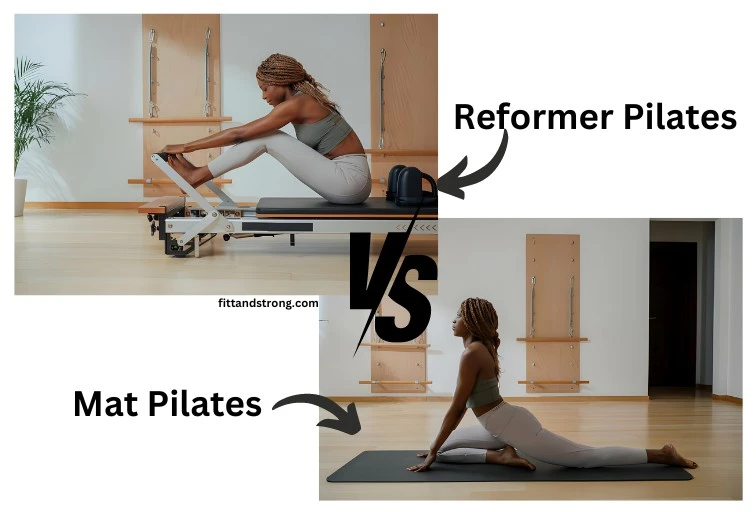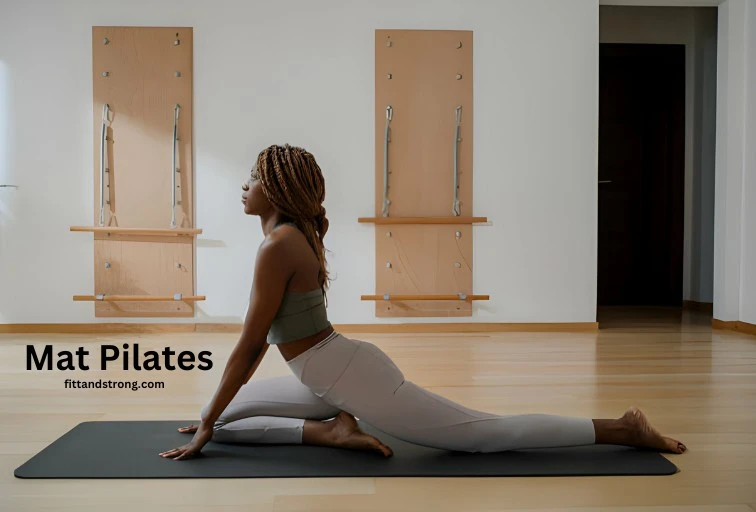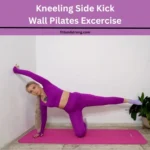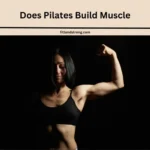In the quest for a low-impact workout that strengthens the core and builds muscular endurance, Pilates emerges as a top contender. Invented by Joseph Hubertus Pilates in the 1920s, this method has evolved into two main styles: mat Pilates and reformer Pilates.

Both promise to stretch, strengthen, and balance the body, utilizing focused breaths for control over each movement.
While they share core principles, mat Pilates offers simplicity and accessibility, needing nothing more than a mat. It’s like yoga’s strength-focused cousin, perfect for those who travel or prefer to practice at home. Reformer Pilates, with its specialized equipment, challenges the body in new ways, offering a distinctive workout experience.
Experts note significant differences between the two, especially in terms of equipment needed, impact on joints, and flexibility in practice location. This makes choosing the right type essential for your workout needs and fitness routine.
Mat Pilates lays a foundation, focusing on mindful movement and full-body alignment. It’s accessible and versatile, making it a great starting point for beginners. Reformer Pilates, on the other hand, uses apparatuses to assist in strengthening and stretching, appealing to those seeking a more intensive practice.
So, whether you’re drawn to the mat for its simplicity or the reformer for its depth, understanding these differences can help you decide Which Pilates Style Best Fits your Body, life, and goals.
How Mat Pilates differs from Reformer Pilates
Once, I Tried Mat Pilates, a simple series of exercises that leverage body weight and props like a ring or ball. It felt grounding and accessible. Mat Pilates requires minimal gear, focusing on body weight to strengthen and stretch.
Switching to Reformer Pilates, the experience was elevated. The Reformer, with its straps, springs, and platform, helps to assist, add intensity, and resistance. It’s like practice with a personal touch, adding weight resistance to each exercise.
In a Reformer Class like Club Pilates, it’s akin to lifting weights in a gym. Yet, the Reformer machine ensures your entire body stays aligned, avoiding the overcompensating of specific movements that often occurs with free weights or other weight machines in a gym.
Comparing the two, Mat Pilates builds a strong foundation, while Reformer Pilates pushes limits with its intense, challenging workouts. Both have their place, but the Reformer offers a more dynamic, comprehensive exercise regime.
11 Reasons To Choose Between Both
Reasons | Mat Pilates | Reformer Pilates |
|---|---|---|
Costly | ✓ | |
✓ | ✓ | |
Improves Posture | ✓ | ✓ |
Promotes Flexibility | ✓ | ✓ |
Teaches Breath Control | ✓ | ✓ |
Offers Full-Body Strength Training | ✓ | |
Improves Balance and Coordination | ✓ | |
Decreases Risk of Injury | ✓ | ✓ |
Offers Greater Variety of Exercises | ✓ | |
Needs No Equipment | ✓ | |
Provides Support for Joints | ✓ | |
Assists in Weight and Resistance Adjustment | ✓ | |
Builds Strength, Toning, and Flexibility | ✓ | ✓ |
Improves Connection of Breath, Mind, and Body | ✓ | ✓ |
To really get into the nitty-gritty of how Mat and Reformer Pilates are different, you’ll need to dive deep into both. So, let’s take a close look at every difference between them.
What is Mat Pilates?
Mat Pilates is a form of exercise that started on the ground, Focusing on the Core, lower, and upper back, leg, and arm muscles. It’s a simple yet advanced workout that leverages body weight.
This workout packs a huge impact with exercises like The Hundred, Teaser, Roll-Up, and Single-Leg Circle. It improves posture and flexibility, building strength across key muscles.
Without the need for supportive apparatuses like a Pilates Reformer machine, you’re fully responsible for your body’s actions. This self-responsibility helps carefully control core muscles during repeated movements.
Pilates instructors often recommend Mat Pilates class for beginners to gain a foundation and full understanding of Pilates. It ensures students are ready to take on the Reformer with confidence.
Mat Pilates provides an unsuspectingly advanced workout that lengthens and tones muscles. It’s a foundation for all Pilates work, preparing the body for more challenging exercises.

Below are more key points about Mat Pilates.
1-Builds Pilates Techniques and Form Skills
Mat Pilates serves as the foundation for learning Pilates movements and techniques. Every mat class introduces the basics of a neutral spine, engaged core, and intentional breathwork. These fundamentals are crucial for both Pilates and non-Pilates workouts.
Practicing on the mat helps in building knowledge that applies to future workouts. Skills like maintaining a neutral spine during a deadlift or using a strong exhale in a push-up are examples of this application.
Experts agree that mat work is the basis of the entire Pilates exercise system. It builds a solid foundation of knowledge, ensuring movements are executed safely and effectively.
Starting with mat Pilates also means you’ll have the know-how to eventually try a reformer Pilates class. Learning and practicing these techniques on the mat ensures you’re ready for more advanced equipment with confidence.
2-Improves Posture
Mat Pilates is known for its focus on strengthening the core and improving posture. Regular exercises like planks and teasers teach body alignment. Practicing Pilates consistently can lead to a noticeably straighter stance in daily life. A study showed that doing Pilates for one-hour twice a week over 12 weeks can significantly improve core posture.
Amy Jordan, a renowned Pilates expert, emphasizes the connection between Pilates and improved posture. Mat Pilates specifically targets the transverse abdominis, enhancing stability and upright posture. If you’re often found slouching at a desk, incorporating Pilates into your routine could be transformative.
The mind-body connection fostered by Pilates makes you more aware of your posture. Engaging in Pilates helps connect to your body’s back line, promoting better posture naturally. Exercises are designed to strengthen and lengthen the back, aiding in postural improvement.
Through repeated practice, Pilates participants learn to maintain a neutral spine in various activities, not just during workouts. This foundation built in Pilates class is essential for executing movements safely and effectively in all physical endeavors.
3-Promotes Flexibility
Mat Pilates specifically targets flexibility, helping you touch your toes easier. Poku emphasizes that practiced regularly, it lengthens muscles effectively. A PubMed study shows participants doing an hour of Mat Pilates twice a week for 12 weeks saw hamstring flexibility improvements.
Different research on being more flexible showed that doing Pilates once a week for half a year made the gap from fingers to the floor smaller. This means a 4.3 centimeters reduction on average, showcasing Pilates’ effectiveness. Mat Pilates not only promotes flexibility but also improves overall body movement.
Focusing on core strength, Mat Pilates also indirectly supports flexibility goals. Regular exercises like planks and hollow body holds contribute to this. Flexibility isn’t just about stretching; Mat Pilates teaches how to maintain it through proper form and breathwork.
In essence, Mat Pilates offers a foundation for achieving major fitness goals, especially in flexibility. It’s an accessible way to enhance physical health and muscle elasticity.
4-Teaches Breath Control
Mat Pilates significantly emphasizes the role of breath control, making it a core component of every workout. Breathing techniques are fundamental, not just for exercise but for fostering a powerful mind-body connection. Your instructor will often remind you to breathe in deeply and exhale forcefully during exercises.
Inhales and exhales in Mat Pilates are timed with movements to increase the effectiveness of each action. As you lengthen your muscles, inhaling deeply enhances the stretch, while exhaling helps contract them, drawing on inner strength.
The mental health benefits of Pilates breathwork are well noted by experts like Poku. Focusing on your breath can increase positive temperament and is a natural way to treat anxiety and depression. Regular practice integrates physical and mental well-being.
A weekly Mat Pilates class that focuses on breath control can pull double duty. It not only improves your physical health but also your mental health, making Pilates a holistic fitness approach.
What is Reformer Pilates?
Reformer Pilates might seem intimidating at first with its elevated apparatus that includes springs, straps, a foot bar, a box, and a platform. Despite looking complicated, it’s designed to provide an impactful workout to lengthen, strengthen, and tone your muscles.
You will find adjusting springs on the Reformer machine becomes easy with practice, as your instructor guides you to move the foot bar up or down. In your first Reformer Pilates class, many exercises will be familiar from Mat Pilates class, but the equipment elevates the challenge.
The equipment helps take your workout to the next level, offering a greater challenge to your body and helping increase your fitness results. Targeted movements in Reformer Pilates coordinate with your breath, working specific muscle groups to improve both strength and flexibility.
Throughout a Reformer Pilates class, you’ll adjust the springs and straps to match your current practice level. This approach makes Reformer Pilates incredibly effective for your entire body, yet it remains low-impact and provides support and mobility assistance.
Professional and Olympic athletes often regard Reformer Pilates as the most effective form of exercise, challenging physical abilities, connecting the mind, and keeping the entire body aligned and supported. David Beckham credits Pilates for getting him into the best shape of his life and reducing body fat.
Despite its far-reaching benefits, Reformer Pilates was not always accessible due to bulky and cost-prohibitive At-Home Reformer machines. However, the advent of home reformer machines has changed this, making it possible to enjoy the benefits and comfort of working out in own homes.

1-Offers Full-Body Strength Training
Reformer Pilates elevates strength training beyond mat Pilates by incorporating springs for resistance, targeting the entire body. It’s a high-intensity training experience that strengthens, lengthens, and tones.
The reformer uses signature springs to add varying levels of resistance, making exercises more challenging than bodyweight exercises alone. This approach enhances muscular strength and endurance.
Pubmed Research highlights the benefit of adding weight in Pilates, increasing the impact on muscle growth through resistance training. Muscles endure and repair, leading to major gains.
This targeted and strategic use of resistance allows for focused work on push muscles like the chest and triceps, as well as the lower body.
Reformer Pilates provides a full-body strength training solution that is both effective and low-impact, supporting and mobility aiding, unlike mat Pilates.
2-Improves Balance and Coordination
The sliding carriage on the Pilates reformer introduces instability to workouts, requiring muscles to be fully engaged and controlled. This unique feature demands precise movement of the platform, either steadily or holding it in same place, enhancing balance and coordination.
Incorporating exercises like reverse lunges where one foot remains on the platform and the other on the sliding carriage challenges your balance skills. Avoiding wobbling during these movements trains the body to maintain stability, a key aspect of Reformer Pilates.
According to a Pilates Instructor, working on this moving machine not only heightens balance but also significantly improves coordination. This dynamic approach makes Reformer Pilates an effective method for enhancing physical capabilities.
3-Decreases Risk of Injury
Reformer Pilates differs from high-impact workouts by keeping your feet on the ground, reducing the risk of injury significantly. Unlike exercises that involve leaving the floor, such as plyometric movements, this method is safer.
The springs on the reformer machine serve a double duty. They not only add resistance, like dumbbells or barbells, but also prevent the platform from excessive moving. This adds an element of support and stability for safer workouts.
According to a Pilates instructor, using springs can help create stability during specific exercises, especially beneficial if recovering from a knee injury. This method allows you to target the hamstring without risking injury by providing stability to the knee joint.
Reformer Pilates ensures that every movement is controlled and supported, making it an ideal choice for those concerned with injury prevention. It’s a thoughtful approach to fitness, emphasizing safety and effectiveness.
4-Offers Greater Variety of Exercises
Reformer Pilates is equipped with attachments, tools, platforms, handlebars, straps, and handles. This setup is a major benefit for those seeking a diverse workout. The amazing variety of exercises you can tackle with a reformer surpasses mat Pilates, allowing for a more targeted and rounded workout.
The expert explains that the reformer’s larger catalog of exercises allows for tension to be targeted in different muscle groups. This is not as feasible with mat Pilates, where you’re more limited in the exercises and body parts you can target.
With a reformer, you can incorporate mermaid oblique crunches and overhead triceps extensions into your workout—exercises not possible with bodyweight Pilates alone. The versatility of the reformer enables a more strategic focus on certain muscle groups.
The addition of resistance springs to the reformer makes it easy to level up your workouts whenever you’re ready. This flexibility ensures that Reformer Pilates remains an effective tool for fitness enthusiasts looking to push their limits.
Benefits Comparison Between Mat Pilates and Reformer Pilates
1 Core Strength & Stability
- Mat Pilates: Excellent for foundational core strengthening, focusing on deep abdominal engagement. ✔️
- Reformer Pilates: Offers deeper core engagement and strengthening due to adjustable resistance. ✔️
2 Flexibility
- Mat Pilates: Good for improving flexibility within the limits of bodyweight exercises. ✔️
- Reformer Pilates: Provides enhanced stretching capabilities through adjustable resistance. ✔️
3 Balance & Coordination
- Mat Pilates: Supports balance and coordination effectively through grounded exercises. ✔️
- Reformer Pilates: Offers advanced balance challenges due to the moving carriage, fostering better coordination. ✔️
4 Muscle Tone & Definition
- Mat Pilates: Builds muscle tone using bodyweight for resistance. ✔️
- Reformer Pilates: Achieves more pronounced muscle definition with customizable resistance. ✔️
5 Accessibility & Convenience
- Mat Pilates: More accessible due to no need for specialized equipment, making it ideal for home workouts. ✔️
- Reformer Pilates: Requires access to reformer machines, less convenient for some due to equipment requirements. ❌
6 Cost-Effectiveness
- Mat Pilates: Generally more affordable with minimal investment needed, suitable for budget-conscious individuals. ✔️
- Reformer Pilates: Higher cost associated with equipment and studio classes, impacting overall affordability. ❌
7 Variety of Exercises
- Mat Pilates: Offers a wide range of exercises but is limited compared to Reformer Pilates. ❌
- Reformer Pilates: Extensive variety due to the machine’s versatility, enhancing workout diversity. ✔️
8 Intensity & Customization
- Mat Pilates: Intensity is modifiable but limited by bodyweight, offering less customization. ❌
- Reformer Pilates: High customization for intensity and difficulty levels with adjustable springs, catering to personalized fitness goals. ✔️
9 Equipment Needed
- Mat Pilates: Requires minimal equipment, usually just a mat and optional small props. ✔️
- Reformer Pilates: Necessitates a Reformer machine, potentially with additional attachments for a comprehensive workout. ❌
10 Suitability for Rehabilitation
- Mat Pilates: Suitable, especially for beginners and those needing low-impact exercises for rehabilitation. ✔️
- Reformer Pilates: Exceptionally suitable due to adjustable resistance and support, ideal for tailored rehabilitation programs. ✔️
“This comparison highlights that each method has its strengths depending on what you value most in a workout—whether it’s accessibility, variety, intensity, or suitability for rehabilitation. Both Mat and Reformer Pilates offer unique benefits, making them complementary practices rather than competitive options.”
Which Pilates is best for beginners?
Mat Pilates is often recommended for beginners because it’s cheaper, easier to start in a class, and focuses on learning and perfecting fundamental Pilates movement techniques, making it highly suitable for those new to Pilates.
Are mat Pilates as effective as reformer?
Mat Pilates and reformer Pilates are both effective, Choosing between them isn’t about which is better but what suits your goals and preferences. Both can improve strength, flexibility, overall fitness, and other body aspects. Your choice should align with your personal fitness goals and preferences.
Is Reformer or mat Pilates better for beginners?
Mat exercises are ideal for new learners because they focus on teaching you to manage your muscle movements during the workouts. While advanced mat classes can be hardest, they teach you to rely solely on your body, without the reformer assisting or supporting.
Is mat harder than reformer?
The difficulty between mat and reformer Pilates varies with personal experience and goals. Mat Pilates relies on body weight for resistance, making some exercises feel more intensive, especially for beginners.
Does Reformer Pilates burn more calories than Mat Pilates?
Yes, Reformer Pilates tends to burn more calories than Mat Pilates for someone weighing 150 pounds. A 50-minute beginner Mat Pilates class burns approximately 175 calories, while an advanced class burns about 254 calories. Reformer Pilates classes, which often elevate the heart rate more significantly, can lead to higher calorie expenditure.
Final Words: So which one?
Choosing between Mat Pilates and Reformer Pilates shouldn’t be a cause for stress. Remember, both methods bring valuable benefits to the table.
The decision between the two boils down to personal preference, fitness goals, and accessibility. Reformer Pilates might edge out for those seeking advanced classes or specific rehabilitation needs, thanks to its versatile equipment. However, Mat Pilates is unparalleled in accessibility and ease, perfect for those who value simplicity and effectiveness.
Ultimately, the key is regular practice and adherence to Pilates’ principles: breath, centering, concentration, control, precision, and flow. Whether on the mat or the reformer, committing to these fundamentals will maximize your results. So, rather than agonizing over the decision, consider incorporating both into your routine to reap the similar benefits each offers.





